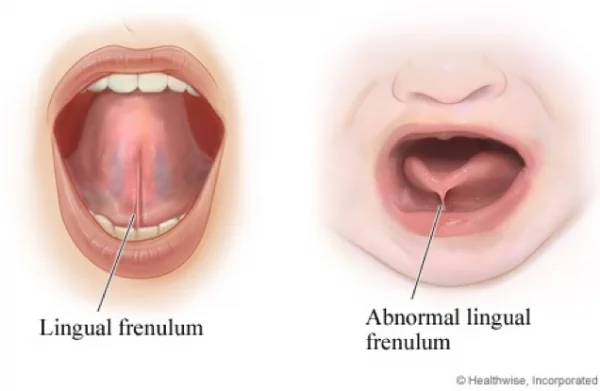
Lip & Tongue Tie
The following story is based on a lip tie procedure* performed by snipping but at DentalCareXtra the preferred approach to treat lip and tongue ties is using soft tissue laser. DentalCareXtra are the only Dental Practitioners in Central Queensland that have invested in this advanced technology and training to give you and yohttp://dentalcarextra.com.auur family the optimal care and results.

The benefits of treatment with laser are that it is less invasive (no cutting or sutures), painless, faster healing, faster recovery, removes bacteria and infection.
Read on to find out how this mother and baby achieved a happy outcome.
My daughter was born in a beautiful water birth. Upon examining her mouth, my midwife noticed that my baby had a tight frenulum, also known as tongue-tie. (The frenulum is the small band of tissue that connects the underside of the tongue to the floor of the mouth.) She mentioned it should not be a problem to nurse her, but that I should pay extra attention to how baby latched on. She said that most of the time the frenulum can stretch enough to breastfeed well. I was also informed that in some cases, tongue-tie babies need a procedure called a frenotomy by an oral surgeon or qualified dentist. In a frenotomy, the frenulum is clipped with scissors, allowing the tongue to move more freely.
Even the hospital paediatrician did not feel my daughter’s tongue-tie would be an issue. The first few days of nursing went well. Then my milk supply increased and my breasts were larger than my baby’s head! My baby could not achieve the proper latch-on to stay on the nipple. She was tired, cranky, gassy, and upset all day and into the next day.
I brought my baby to our paediatrician and asked about her tongue. She did not seem concerned and stated that “no one clips these days.” I did everything I could to assist my baby to latch on, and as this is my second baby, I knew what a proper latch-on felt like.
Days later I was sore, frustrated, and feeling really tired. Baby was very fussy when hungry because she wanted to nurse but was unable to stay latched on. I knew we had to get professional help. I contacted the Lactation Resource Centre and made an appointment. I immediately felt at ease as they weighed her, watched me nurse her, and weighed her again. She had taken in four ounces of my milk, but it was really a struggle. My nipples were cracked, bruised, and hurting.
The lactation consultant suggested pumping and feeding with a bottle (designed for switching between bottle and breast) until I could get an appointment with an oral surgeon. She felt that my baby might need to have a frenotomy, a procedure my husband and I were both unsure about.
All I knew was that I would do anything it took to ensure baby got my milk, even if it meant bottle-feeding. I also purchased a nipple shield and several hydrogel compresses for breast comfort. The thought that my daughter might become dependent on bottles concerned me. I had read horror stories of nipple confusion and I did not want to pump for the rest of my breastfeeding time, but desperate times called for desperate measures. I needed to ensure that our breastfeeding would eventually work out for both of us. I had to bottle-feed baby my milk and then rush off to pump more.
The whole process was time-consuming and I was exhausted, but we survived from Friday until Monday. When we had the consultation with the oral surgeon, he told me he had four adult children and seven grandchildren, all breastfed, so he knew the importance of good latch-on. He did say, however, that if he lifted baby’s tongue and found it appeared to be able to stretch out he would send me home. If he looked and found classic tongue-tie he would put lidocaine gel (a topical anaesthetic) on the frenulum, cut it, put pressure on the incision with a gauze, and then send me to breastfeed in their nursing room.
As the nurse and I held my daughter, she began to cry. The doctor looked and said, “Classic tongue-tie.” He numbed the area, clipped, applied pressure, and off I went to nurse my newborn without any problems for the first time in a week. She was like a new baby! Soon, I was a happy, breastfeeding mother and my nipples were healing well.
My baby is a happy breastfed baby. Well, she still is cranky around the evening, but she is breastfeeding and gaining weight. I would not give up on nursing my baby. I am so glad that I got information and health care to make it happen.
For more information on Lip & Tongue Tie
Research for Tongue-Tie In 2005, the results of a study on tongue-tie in infants with feeding problems was published in The Journal of Paediatric Child Health. The objective was to determine whether referral to a lactation consultant or immediate division of the frenulum works best and enables the infants to feed normally. A group of 28 babies had immediate divisions; afterwards, 27 improved and fed normally. A group of 29 babies and their mothers received 48 hours of intensive lactation consultant support. In this group, one baby improved. The remaining 28 were offered division, which all of the mothers accepted; 27 of these babies improved and fed normally. Overall, the division of the frenulum resulted in improved feeding in 95% of the tongue-tie babies in the study. The researchers concluded that tongue-tie can affect feeding and that “division is safe, successful, and improved feeding for mother and baby significantly better than the intensive skilled support of a lactation consultant. Source: Hogan, M., Westcott, C., and Griffiths, M. “Randomized, controlled trial of division of tongue-tie in infants with feeding problems.” J Paediatr Child Health 2005; 41:246-50
For more information on lip and tongue-tie treatments, please do not hesitate to contact DentalCareXtra. Alternatively, complete the form below, and one of our friendly team members will contact you.
* Any surgical or invasive procedure carries risks. Before proceeding, you should seek a second opinion from an appropriately qualified health practitioner.






